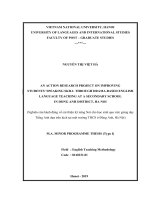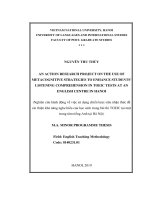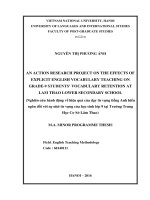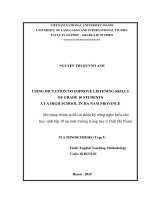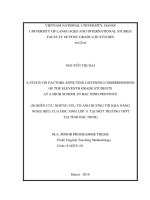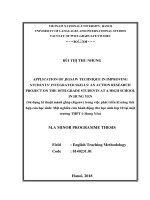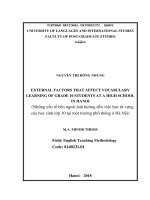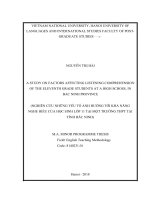Application of jigsaw technique in improving students’ integrated skills an action research project on the 10th grade students at a high school in hung yen
Bạn đang xem bản rút gọn của tài liệu. Xem và tải ngay bản đầy đủ của tài liệu tại đây (1.62 MB, 80 trang )
VIETNAM NATIONAL UNIVERSITY, HANOI
UNIVERSITY OF LANGUAGES AND INTERNATIONAL STUDIES
FACULTY OF POST-GRADUATE STUDIES
------
BÙI THỊ THU NHUNG
APPLICATION OF JIGSAW TECHNIQUE IN IMPROVING
STUDENTS’ INTEGRATED SKILLS: AN ACTION RESEARCH
PROJECT ON THE 10TH-GRADE STUDENTS AT A HIGH SCHOOL
IN HUNG YEN
(Sử dụng kĩ thuật mảnh ghép (Jigsaw) trong việc phát triển kĩ năng tích
hợp của học sinh: Một nghiên cứu hành động cho học sinh lớp 10 tại một
trường THPT ở Hưng Yên)
M.A MINOR PROGRAMME THESIS
Field
: English Teaching Methodology
Code
: 8140231.01
Hanoi, 2018
VIETNAM NATIONAL UNIVERSITY, HANOI
UNIVERSITY OF LANGUAGES AND INTERNATIONAL STUDIES
FACULTY OF POST-GRADUATE STUDIES
------
BÙI THỊ THU NHUNG
APPLICATION OF JIGSAW TECHNIQUE IN IMPROVING
STUDENTS’ INTEGRATED SKILLS: AN ACTION RESEARCH
PROJECT ON THE 10TH-GRADE STUDENTS AT A HIGH SCHOOL
IN HUNG YEN
(Sử dụng kĩ thuật mảnh ghép (Jigsaw) trong việc phát triển kĩ năng tích
hợp của học sinh: Một nghiên cứu hành động cho học sinh lớp 10 tại một
trường THPT ở Hưng Yên)
M.A MINOR PROGRAMME THESIS
Field
: English Teaching Methodology
Code
: 8140231,01
Supervisor
: Prof. Dr. Hoàng Văn Vân
Hanoi, 2018
DECLARATION
I, the undersigned, declare that this thesis is the results of my own
research and has not been submitted to any other university or institution
partially or wholly. Except where the reference is indicated, no other person‟s
work has been used without due acknowledgement in text of the thesis.
Student
Bui Thị Thu Nhung
In my capacity as supervisor of the candidate‟s thesis, I certify that the
above statements are true to the best of my knowledge.
Supervisor
Prof. Dr. Hoang Van Van
i
ACKNOWLEDGEMENTS
First of all, the researcher would like to express her gratitude to the
Dean, the Vice Dean and all staffs of the Faculty of Postgraduate Department
for their priceless wisdom, encouragement, help and kindness during her
study and writing this thesis.
In the second place, she wishes to extend her great honor and deepest
gratitude to her adviser, Prof. Dr. Hoang Van Van, for his invaluable
guidance, correction, facilitation and encouragement in the writing of this
thesis.
Her special thanks also are forwarded to Mr. Do Ba Muoi, the
Headmaster of Nguyen Sieu High School, who had permitted her to conduct
this research in his school. Her thanks are presented to all the English teachers
of the school‟s English group for their help and advice during the
implementation of the research. And then, her great thanks are extended to
students of class 10A1 of Nguyen Sieu High School for their cooperation
during the time the research was conducted.
Finally, she would like to thank her family, her friends for their spirit,
encouragement and their support. Without them this thesis couldn‟t be
accomplished.
ii
ABSTRACT
Mastering all four language skills is very essential to successful
communication, and is the main target of all language learners. Understanding
this need and the problems that learners face during learning English, this
action research was conducted with the aim at improving students‟ integrated
skills through Jigsaw technique to the tenth grade students of Nguyen Sieu
High School in the academic year of 2017-2018 and investigating their
attitudes toward this technique. Thirty five participants were involved in the
research during 12 weeks of the second term. The present study was
concerned with the integration of all language skills through Jigsaw technique
by administering pre-test, post-test and questionnaire as the research
instruments. The results showed that students‟ achievements in all four
language skills were higher after the intervention. Although the general
achievement is not so impressive, it however indicated that Jigsaw learning is
still an effective learning method and worth applying in teaching integrated
skills. Besides, most of the students showed their agreement on the use of
Jigsaw as it helped them to be more motivated, active, and engaged in
learning. It also created a friendly learning environment where students felt
more confident, cooperative and responsible during learning process. In
general, Jigsaw technique improved students‟ outcomes academically,
socially and psychologically.
iii
TABLE OF CONTENTS
DECLARATION .............................................................................................. i
ACKNOWLEDGEMENTS............................................................................ ii
ABSTRACT .................................................................................................... iii
TABLE OF CONTENTS............................................................................... iv
LIST OF TABLES ......................................................................................... vi
LIST OF GRAPHS ....................................................................................... vii
PART A: INTRODUCTION.......................................................................... 1
PART B: DEVELOPMENT........................................................................... 6
CHAPTER I: LITERATURE REVIEWS .................................................... 6
1.1 Definition of key terms ............................................................................................. 6
1.1.1 Cooperative learning ............................................................................................. 6
1.1.2 Integration of language skills .............................................................................. 7
1.1.3 Jigsaw technique ..................................................................................................... 9
1.2. Advantages and disadvantages of using Jigsaw technique .......................... 10
1.2.1 Advantages of using Jigsaw technique ............................................................ 10
1.2.2 Disadvantages of using Jigsaw technique ...................................................... 12
1.3. The roles of teacher and students in Jigsaw class ........................................... 13
1.3.1 Teacher’s roles ...................................................................................................... 13
1.3.2 Students’ roles ....................................................................................................... 13
1.4. Strategy to conduct Jigsaw ................................................................................... 14
1.5. Previous studies ....................................................................................................... 16
CHAPTER II. METHODOLOGY .............................................................. 16
2.1. Research method ..................................................................................................... 23
2.2. The participants ....................................................................................................... 24
2.3 The textbook .............................................................................................................. 24
iv
2.4. Implementation of the action ............................................................................... 27
2.5. Research instruments ............................................................................................. 28
2.5.1. Pre-test and post-test .......................................................................................... 28
2.5.2. Questionnaire ....................................................................................................... 29
2.6. Data collection and analysis ................................................................................. 29
CHAPTER III. FINDINGS AND DISCUSSIONS .................................... 31
3.1. Data tabulation and description ........................................................................... 31
3.2 Data analysis ............................................................................................................. 33
3.2.1. Achievements ........................................................................................................ 33
3.2.2 Attitudes .................................................................................................................. 37
3.3 Discussion of the findings...................................................................................... 38
3.3.1 Achievement ........................................................................................................... 38
3.3.2 Attitudes .................................................................................................................. 40
PART C: CONCLUSION AND RECOMMENDATION ......................... 42
REFERENCES .............................................................................................. 45
APPENDICES .................................................................................................. I
v
LIST OF TABLES
Table 1: Tabulation of data showing the subjects‟ scores in integration of four
skills through Jigsaw technique ...................................................................... 32
Table 2: Students‟ responses to the two „open-ended‟ questions ................... 33
Table 3: Summary of the research finding showing the mean score from pretest and post-test of four language skills ......................................................... 34
Table 4: Analysis of Pre-test and Post-test scores of students‟ performance on
four skills ......................................................................................................... 35
vi
LIST OF GRAPHS
Graph 1: The students‟ progress in each language skills through Jigsaw
technique ........................................................................................................ 35
Graph 2: The progressing of grand mean in students‟ achievement in
integrated skills through application of Jigsaw technique .............................. 36
vii
PART A: INTRODUCTION
In this chapter, the background to the problem and the reason for
choosing the topic are mentioned. As a result, the necessity of delivering the
research as well as the importance of the application of Jigsaw technique in
integrating all English language skills is revealed. The aims and the
significances of the study are also stated. The final section will present the
scope of the study which shows the number of participants and the time of the
intervention.
1. Rationale
In the context of integration and globalization, English is now
becoming one of the most effective means of communication in the world and
Vietnam is also no exception. Hence, foreign language teaching, especially
English, is more and more essential and the master of foreign language –
English - appears as an urgent requirement at present. People now have
witnessed many significant changes in education and teaching methodology
in which learners increasingly become the center of teaching and learning, as
well as the changes from traditional approach to communicative approach. In
English, if grammar had been the focus of language learning for decades, it is
now seen as an instrument to master language skills, including reading,
writing, listening and speaking skills, which are much more necessary in
communication. The primary goal of teaching and learning English is to
enable students to use the language to communicate and interact with others
as „when people learn a foreign language, they usually want to make use of
that language to communicate with people who speak the same language.
They can find themselves in the need of understanding them and talking to
them.” (Raimes, 1983). The problem is that although learners have an
1
acceptable knowledge of language components, they can rarely use them to
communicate in English. It is because most of the class time is spent for
learning grammar, vocabulary or isolated language skills; hardly do they have
time to practice using all language skills in integration. According to Breen
and Candlin (2001)‟s views, “Just as no single communication ability can
develop independently of other abilities, so the development of one skill may
well depend on the appropriate development of other skills.” (Breen &
Candlin, 2001, p.15). Besides, recent research (e.g. Bose, 2003; Faydi, 2003;
Hefferman, 2006) also showed that the integration of language skills plays
significant role in improving language learning achievements. As a result,
instead of using one single, separate language skill, learners need to combine
or integrate four skills to have successful communication. This is also a
challenge for English language teachers to create communicative activities
that help learners make use of all four language skills at the same time.
Through skills integration, English language learners are exposed to authentic
materials and challenges that encourage them to interact naturally; and in
language teaching, a successful English teacher is one who can help learners
actually communicate in English inside and outside the classroom.
Furthermore, to communicate successfully, not only do students need to
master English grammar or skills, but they must also be confident, initiative,
freely and flexible in a wide range of communicative situations. In order to
achieve this, students first and foremost must be themselves in classroom, be
able to use English to solve any learning situations or tasks in class and be
cooperative with each other. However, this arises as a challenging problem in
teaching and learning English, especially in rural areas where students are not
very good at English. They are often shy, passive or unconfident to
communicate with each other in English. Therefore, the cooperative learning
2
among students is very essential as it not only creates a foreign language
environment for the students themselves but also helps them feel more
motivated, comfortable, confident and autonomous when working together in
a friendly but meaningful learning environment.
Jigsaw is a cooperative learning technique that requires everyone‟s
cooperative effort to produce the final product as “each member of a group
has a piece of information needed to complete a group task” (Richards, Platt
& Platt, 2008). Jigsaw is said to be able to increase students‟ learning since
“a) it is less threatening for many students, b) it increases the amount of
student participation in the classroom, c) it reduces the need for
competitiveness and d) it reduces the teacher‟s dominance in the classroom”
(Richards, Platt & Platt, 2008). Consequently, Jigsaw strategy can
successfully reduce students‟ reluctance to participate in the classroom
activities and help create an active learner-centred atmosphere.
Studies related to the implementation of jigsaw technique in
Vietnamese language classes have in fact been carried out in college settings,
mostly in terms of increasing students‟ motivation and cooperation in class.
More studies then need to be conducted to ascertain the implementation of
Jigsaw technique in other settings, in this case in high schools. This particular
concern arouses the writer to conduct a study on the use of Jigsaw technique
in teenager learners‟ language class in discovering the integration of different
language skills.
2. Aims and research questions of the study
Based on the rationale mentioned above, the researcher would like to
investigate the impacts of Jigsaw technique on students‟ integrated language
skills and their attitudes towards the new technique – Jigsaw – in her own
teaching environment to see whether it is applicable at Nguyen Sieu High
3
School or not. An action research will be conducted to address the following
research questions:
1. To what extent can the use of Jigsaw technique improve the students’
integrated skills?
2. What are the students’ attitudes towards the new technique – Jigsaw?
Of these two questions, the first one is the focus of the study.
3. Significance of the study
Theoretically, this thesis will be a small contribution to the theory of
ELT on the impacts of using Jigsaw technique in promoting students‟
language competence of four skills reading, speaking, listening and writing at
the same time in EFL classrooms at a high school.
Practically, this study is firstly expected to be an alternative way to
expose students to more student-centered classrooms, and hopefully to help
them enhance their English competence, cooperation and their motivation in
those classes. The results of this research are expected to give useful
information and experience to English teacher whether or not Jigsaw
technique is an effective way to improve students‟ language competence. If
this method is successful, it may possibly be widely applied at a high school
to make the students interested in English and more confident to communicate
with each other in the target language.
4. Scope of the study
First, the scope of this research is confined to its population and will be
conducted in 12 weeks of the second term in the academic year 2017-2018.
Only one class with 35 students at grade 10 of Nguyen Sieu High School will
be investigated. Besides, the research covers some lessons which are
presented in the units of the textbook „Tieng Anh 10‟, published by Vietnam
Education Publishing House (2018).
4
5. Design of the study
This study is divided into three parts:
PART A: THE INTRODUCTION - presents the rationale for the
study, the aims to which the study is conducted, the research questions, the
scope and the significance of the study, and the design of the study.
PART B: THE DEVELOPMENT consists of three chapters.
Chapter I: Literature reviews - provides the definitions of some key
terms, and the previous research related to the study as well as the gaps in the
field which inspire the writer to conduct the research. Besides, this chapter
also delivers some presentations about the advantages and disadvantages of
Jigsaw technique, the roles of the teacher and students in Jigsaw class and the
strategy to conduct the technique.
Chapter II: Methodology - describes the research method, the
participants, the textbook, and the method to collect and analyze the data.
Chapter III: The presentation of the findings - presents the data
tabulation and description, data analysis and discussion of the findings.
PART C: CONCLUSION - briefly summarizes the study; besides,
some limitations of the study and recommendations for further research are
also proposed.
5
PART B: DEVELOPMENT
CHAPTER I: LITERATURE REVIEW
This chapter presents the definitions of some key terms which are
frequently used and affect the main purposes of the research. Significantly, a
careful and thorough review of previous studies about the implementation of
Jigsaw technique in teaching and learning English language knowledge and
skills is mentioned. Some space is also devoted to the discussion of the
advantages and disadvantages when applying Jigsaw technique in teaching. In
addition, the next part of this chapter is about the roles of teacher and students
in Jigsaw class. Finally, the strategy of conducting Jigsaw technique which is
used in this research will be presented.
1.1 Definition of key terms
1.1.1 Cooperative learning
Several definitions of cooperative learning have been formulated.
According to the Johnson & Johnson model (1991), cooperative learning is
instruction that involves students working in teams to accomplish a common
goal, under conditions that include the following elements:
- Positive interdependence
- Individual accountability
- Face-to-face promotive interaction
- Appropriate use of collaborative skills
- Group processing
Cooperative learning is not simply a synonym for students working in
groups. A learning exercise only qualifies as cooperative learning to the
extent that the five listed elements are present.
6
Another definition of cooperative learning is defined by Cruickshank,
Jenkins and Metcalf (2009) as “instructional procedures whereby learners
work together in small groups and are awarded for their collective
accomplishments.” In a somewhat similar manner, Slavin (2011) defines
cooperative learning as “instructional methods in which teachers organize
students into small groups, which then work together to help one another
learn academic content”.
In general, cooperative learning is a kind of teaching method in which
students work together to achieve common goals in their learning process. It
is organized in order to create a positive learning environment where students
can interact with each other to construct knowledge; they become more
motivated, active, independent and collaborative in learning. Teacher
becomes facilitator, motivator, and controller to help them work together
more effectively.
1.1.2 Integration of language skills
As Peregoy & Boyle (2001) stated in Chen (2007), “in natural, day-today experience, oral and written languages are not kept separate and isolated
from one another. Instead, they often occur together, integrated in specific
communication events.”
Moreover, Chen (2007) considers that during “the language learning
process, listening, speaking, reading and writing should be treated as
integrated, interdependent, and inseparable elements of language.”
Hungyo and Kijai (2009) explain that the “term integrated means
language learning where all four skills take place at the same time and with
teacher, learner, and setting as playing their roles in the learning.”
It is undeniable that a combination of four skills is extremely necessary
for a successful communication. To enable students to use English in real-life
7
communication, the teacher should create opportunities for them to develop
their own learning in which they can enhance and integrate all four language
skills. Peregoy & Boyle (2001) suggest that reading and writing as well as
speaking and listening should be integral parts of all language classroom
activities because all these processes interact with one another.
Why to integrate?
In real-life communication, people use a variety of language skills reading, listening, speaking and writing. Byrne (1991) states that “one should
keep in mind that these skills are normally integrated in real life”. It is the
same in language learning as learners desire to understand and to be
understood when using a foreign language. It is essential for students to
understand the language they are exposed to and to respond appropriately to
become competent users of that particular language. For example, learners not
only listen to, but they also need to react to the speakers in an oral or written
form appropriately. Communication skills of the learners improve as the
effective usage of integrated skills. Hersan (1998) points out that “Nowadays,
communication is the major aim for learning a foreign language. In daily life,
these skills are seen in integration, for example, after reading a letter, usually
an answer to this letter is written. So, in the classroom the activities should be
taught in integration in order to arrive at ease in communication”. This leads
us to the integration of different language skills in language teaching and
learning. Appropriate application of integration of skills can assist the
instructors in getting better output from the learners. As a result, it can be said
that the more the skills are taught separately, the less communication will take
place in the classroom. To avoid this, the skills should be taught in integration
to instruct learners to develop their communicative competences as well as
learning outcomes.
8
To attain this aim, teacher should pay more attention to the integration
of language skills while teaching so as to encourage individuals to become
communicatively competent. Thus, creating a safe free-stress learning
environment to motivate the students to participate in learning becomes more
and more necessary. Using information-gap task with authentic materials will
encourage learners to enjoy the lessons more, then learning outcomes will be
improved. This is also the aim of the study which hopes to clarify the use of a
teaching technique - Jigsaw - providing a friendly natural learning
environment for students and attaining greater achievements too.
1.1.3 Jigsaw technique
The Jigsaw technique, initially developed by Elliot Aronson in the early
1970s, is one of the earliest of the cooperative learning techniques that are
documented. The Jigsaw method is an effective way to increase student
engagement through group work that facilitates peer-to-peer learning. As one
of the most effective forms of cooperative learning, Jigsaw is a teaching
strategy that helps students to develop skills for working effectively in teams,
an important competency for socio-environmental synthesis.
Brown (1994) states that “Jigsaw technique is a special form of
information gap in which each member of a group is given some specific
information and the goal is to pool all information to achieve some objective”.
More specifically, Brisk and Margaret (2000) define the jigsaw
approach as “a way for students to work cooperatively and help each other to
learn new material. Students take an active role their learning as they teach
other students what they have learned”.
As one of cooperative learning methods, students are required to work
in group in Jigsaw. Aronson in Slavin (1985) says “Jigsaw was one of the
earliest of cooperative learning method. In Jigsaw, each student in a five-to9
six member group is given unique information on a topic that the whole group
is studying”. In addition, in Jigsaw every student is so essential for their group
because each of them is an expert in their group. According to Aronson in
, “just as in jigsaw puzzle, each piece – each
student‟s part is essential for the completion and full understanding of the
final product. If each student‟s part is essential, then each student is essential,
and that is precisely what makes this strategy so effective”.
Based the explanation above, the writer concludes that Jigsaw
technique is a kind of cooperative learning technique that requires students to
work in team. Each student becomes an expert responsible for their part to
study the material, which is broken into pieces, which is very vital to the
completion of the group‟s task. In Jigsaw group, students have to depend on
each other to succeed. As a result, if each student completes their task well
and responsibly, then the whole group will get the best achievement of the
final work.
1.2. Advantages and disadvantages of using Jigsaw technique
1.2.1 Advantages of using Jigsaw technique
- Jigsaw stimulates students’ motivation and engagement in learning
Students are said to be more motivated to learn a language as they have
more chances to interact with other students and the teacher. Jigsaw strategy
encourages students to become engaged in their learning. It motivates them to
learn a lot of materials quickly and inspires them to share information with
peers. In general, the jigsaw classroom stimulates students‟ motivation and
increases enjoyment of the learning experience and promotes a great deal of
negotiation for meaning (Qiao & Jin, 2010).
- Students become more confident, less reluctant and anxious
Students do not have to read a long text, instead they read one part of
10
the text so that they will have better and deeper understanding of the content.
Then they can confidently exchange information in their group successfully.
Speaking is less stressful as reading gives them some ideas to exchange.
Besides, Jigsaw technique is a cooperative learning method which means that
students can learn in a friendly learning environment where they will not
worry about teacher‟s judgments. They can share and discuss the information
with the help from other classmates and the teacher without being afraid of
making mistakes or having nothing to talk. As a result, the students will be
more willing to interact, enjoy the lesson more and have more fun in class. In
general, the method has increased their self-confidence, interest for learning
and allowed them to be more active in the classroom (Sahin, 2010).
- Teacher is not the sole provider of knowledge.
If in the traditional teaching method the teacher is the master of all
knowledge and students are passive to absorb, Jigsaw technique provides
learners with more active roles in constructing and meaning during reading,
writing and conversational exchange with their partners. Teacher becomes a
facilitator who guides and designs cooperative learning opportunities among
learners. Teacher will move back to the class to observe and control the
activities
while students
take over the
responsibility of learning
autonomously.
- Jigsaw builds interpersonal and interactive skills.
Because Jigsaw technique is a cooperative learning technique where the
students work in group to study the materials of their part, so it will make
students to create a relation, cooperate and share each other for finishing their
task. The task cannot be completed successfully if each member of the group
does not finish their part. Therefore, students have to work together and are
responsible for their part. Group working skills and cooperation are built
among the students; it requires them to work effectively and responsibly to
11
attain the final goal of the learning process.
- Jigsaw helps students increase their academic achievement.
As being approved by a numerous research, students in the Jigsaw
group had higher scores as they master their topic, try to make their friends
understand the topic, and have effective interactions with their friends. As a
result, Jigsaw helps students learn English more effectively. The students
achieved marks that were significantly higher than before as well as a
reduction in the number of failures (Honeychurch, 2012). “When designed
well, these tasks are challenging and engaging, and my students enjoy
wrapping their minds around a problem. Since they are working in groups, no
kids have to sink or swim on their own, they have the help of their peers”
(Bafile, 2008).
1.2.2 Disadvantages of using Jigsaw technique
The implementation of Jigsaw technique may encounter some
problems. Firstly, students in general dislike working in groups; the main
complaint is that slacker can take advantage of students who do the work
(Donald, 2005). Also, in his research, he reported that many students
paradoxically said they felt that they learned more by the active method –
Jigsaw, but preferred passive learning. He found that while there were group
goals (preparing for the exams and answering a quiz), there was no
accountability of the individual to the group (lazy students were allowed to
take advantage of the group) or of the individual to a daily standard of
achievement (i.e., quizzes weren‟t graded). Secondly, with reference to the
Huang, et al (2014)‟s study, high-achievement students may not satisfy with
the jigsaw method because of the too easy learning content. In similar context,
Robinson (1991) stated that the motivation of students could be affected by
the type of task given to them depending on the level of difficulty. Thus, the
high-achievement students are more likely to enjoy working together if the
12
task is challenging to them. Other problem that Jigsaw class may encounter is
noise. As students work in group and are free to talk or discuss the
information, the class may become noisy and out of control if the teacher is
not good at class management.
1.3. The roles of teacher and students in Jigsaw class
1.3.1 Teacher’s roles
If in traditional teaching method the teacher is the main source of
knowledge, it no longer happens in Jigsaw classroom where he or she stays
back to the class to observe and provide help. Before Jigsaw activity is
delivered, it is important for the teacher to give clear and appropriate
explanation or instruction and to demonstrate the activity with students, so
that no one is in doubt about what they should do and the activity can run
smoothly from the beginning to the end. Besides, the teacher can become a
prompter or participant to encourage students to actively involve in the
activity. The teacher and students may talk to each other communicatively as
a way to support, guide them naturally without disrupting their learning. The
teacher is also time manager to control the activity so that the students will
not be over-focused on any steps in Jigsaw learning. Finally, feedback
provider is other role of the teacher in class. It is advisable for the teacher to
be tactful in giving feedback in particular situations in order for the students
not to feel shy, discouraged or unclear about what they have done. The
feedback, however, should be clear, correct and helpful so that the students
can attain the knowledge fully and correctly as well as improve their spirit
and motivation through the activity.
1.3.2 Students’ roles
As Jigsaw is one of cooperative learning techniques, it means that the
students must be actively involved in the learning process. They are now the
constructor of knowledge rather than simply repeating the language. They
13
need to negotiate the meaning to understand the content of the lesson.
Aronson (2005) particularly points out: “First and foremost, it is a remarkably
efficient way to learn the material. But even more important, the Jigsaw
process encourages listening, engagement, and empathy by giving each
member of the group an essential part to play in the academic activity.” Here,
students have the opportunity to teach themselves, instead of having materials
presented to them. Each of them becomes an expert in their field and becomes
a teacher to teach others. In other words, each student has a chance to
contribute meaningfully to the discussion, constructing the knowledge and
must be responsible for that. Besides, through each Jigsaw activity, teacher
can assign students‟ role differently like leader, recorder, spokesperson,
timekeeper, encourager, etc. It means that the students will experience many
roles in group activity which will encourage them to be more active and enjoy
the lesson more. The only problem is that students are usually reluctant to
perform in class. Therefore, it is very essential for the teacher to use various
interesting activities and to get the students actively involved.
1.4. Strategy to conduct Jigsaw
The application of Jigsaw technique may follow the following steps:
Step 1: Choosing a passage
Based on each unit in the teaching material, teacher may choose a text
that includes several passages with separated content and divide them into
parts for group work. If there is a long passage, the teacher may need to adapt
it to be appropriately used in Jigsaw learning.
Step 2: Dividing the students in Jigsaw groups
Based on the number of the passages, the teacher may group students
with 4 to 5 for each, they can be encouraged to give their group a name that
indicates their identity. The grouping may be formed differently in each
Jigsaw lesson, the groups should be diverse in gender, ethnicity, race, interest,
14
and ability, so that students will not work permanently for a long time, which
may cause boring. Instead, the changes and diversity in group work make
students more interested and have new experience in the lessons.
Step 3: Studying new words
One of the most challenges in understanding the content of the lesson
that students often encounter is new vocabulary. Therefore, to avoid this
obstacle and help students study and understand the lesson more, the teacher
should provide them with important vocabulary. However, the number of new
words introduced should be limited from 8 to 10 key words which may affect
students‟ understanding of the lesson as well as to spend time for group work
activity.
Step 4: Forming expert group
Students are required to move to the expert groups, each of which is
dealing with one paragraph of the reading passage.
To make the group work run effectively, one member of the group
should be appointed to be the leader controlling the activity and discussion in
group. A number of tasks can be designed, gap-filling, answering questions,
true/false for example, to guide students in studying the main idea of the
passage or important information that teacher wants them to focus on. Make
sure that all students in expert group take note of what they have discussed so
that they will have something to share with friends later.
Step 5: Students returning to their jigsaw groups
This step accounts for most of time in jigsaw class as each expert - each
member of the group has to present what they have learnt in expert group. In
other words, the member of each jigsaw group has to teach each other their
assigned paragraph respectively. Other students need to listen carefully and
take note of the information they need, they can post any questions for
15
clarification. This is where the Jigsaw merges into the final cohesive whole.
The teacher may make an appropriate intervention if any group has problems
in discussion. To help students get the whole picture of the content of the
reading text, the teacher may ask them to make a mind-map or draw a table to
show their information.
Step 6: Checking understanding
To make sure all students work in jigsaw learning, the teacher may
design different activities to check students‟ understanding randomly by
calling any individual in the group to do a task designed. For example,
students are asked to give a short presentation in front of the class about what
they have learnt. Or to involve more students in speaking activity, the teacher
may ask some students to ask and answer about the content of the lesson.
Alternatively, the teacher may require students to conduct a creative writing
about what they have learnt. In general, checking activities should be flexible
and various to attract more students and help them engaged in learning.
1.5. Previous studies
As being mentioned above, Jigsaw technique is one of the most
effective cooperative learning methods, thus up to present there are a great
number of research studying the efficiency of Jigsaw technique in English
language teaching and learning in different levels and subjects, as well as
investigating its affect on English language components and skills.
- The effect of Jigsaw technique on English language components
Hiiseyin Evcim and Omer Faruk Ipek (2013) conducted a study to
determine the effectiveness of Jigsaw II on English pre-school students‟
academic achievements in vocabulary, grammar, and pronunciation. Forty
eight participants joined the study. They were asked to learn the present
perfect tense, the words just, yet and already in Jigsaw model. According to
16
